Practical Geometry-Solutions 14.5
CBSE Class –VI Mathematics
NCERT Solutions
Chaper 14 Practical Geometry (Ex. 14.5)
NCERT Solutions
Chaper 14 Practical Geometry (Ex. 14.5)
Question 1. Draw of length 7.3 cm and find its axis of symmetry.
Answer: Axis of symmetry of line segment will be the perpendicular bisector of So, draw the perpendicular bisector of AB.
Steps of construction:

(i) Draw a line segment = 7.3 cm
(ii) Taking A and B as centres and radius more than half of AB, draw two arcs which intersect each other at C and D.
(iii) Join CD. Then CD is the axis of symmetry of the line segment AB.
Question 2. Draw a line segment of length 9.5 cm and construct its perpendicular bisector.
Answer: Steps of construction:
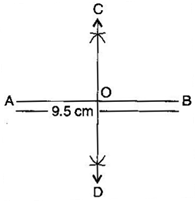
(i) Draw a line segment = 9.5 cm
(ii) Taking A and B as centres and radius more than half of AB, draw two arcs which intersect each other at C and D.
(iii) Join CD. Then CD is the perpendicular bisector of .
Question 3. Draw the perpendicular bisector of whose length is 10.3 cm.
(a) Take any point P on the bisector drawn. Examine whether PX = PY.
(b) If M is the mid-point of , what can you say about the lengths MX and XY?
Answer: Steps of construction:
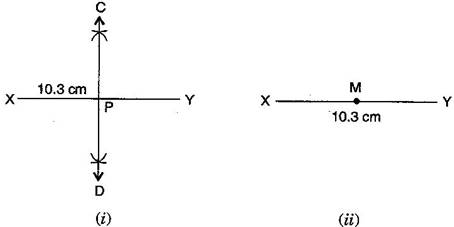
(i) Draw a line segment = 10.3 cm
(ii) Taking X and Y as centres and radius more than half of XY, draw two arcs which intersect each other at C and D.
(iii) Join CD. Then CD is the required perpendicular bisector of .
Now:
(a) Take any point P on the bisector drawn. With the help of divider we can check that .
(b) If M is the mid-point of then .
Question 4. Draw a line segment of length 12.8 cm. Using compasses, divide it into four equal parts. Verify by actual measurement.
Answer: Steps of construction:
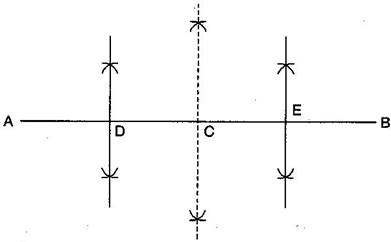
(i) Draw a line segment AB = 12.8 cm
(ii) Draw the perpendicular bisector of which cuts it at C. Thus, C is the mid-point of
(iii) Draw the perpendicular bisector of which cuts it at D. Thus D is the mid-point of .
(iv) Again, draw the perpendicular bisector of which cuts it at E. Thus, E is the mid-point of .
(v) Now, point C, D and E divide the line segment in the four equal parts.
(vi) By actual measurement, we find that
cm
Question 5.With of length 6.1 cm as diameter, draw a circle.
Answer: Steps of construction:
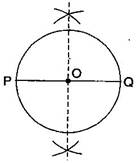
(i) Draw a line segment = 6.1 cm.
(ii) Draw the perpendicular bisector of PQ which cuts, it at O. Thus O is the mid-point of .
Taking O as centre and OP or OQ as radius draw a circle where diameter is the line segment .
Question 6.Draw a circle with centre C and radius 3.4 cm. Draw any chord Construct the perpendicular bisector and examine if it passes through C.
Answer: Steps of construction:
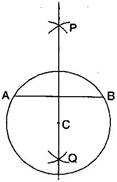
(i) Draw a circle with centre C and radius 3.4 cm.
(ii) Draw any chord
(iii) Taking A and B as centers and radius more than half of draw two arcs which cut each other at P and Q.
(iv) Join PQ. Then PQ is the perpendicular bisector of
This perpendicular bisector of passes through the centre C of the circle.
Question 7.Repeat Question 6, if happens to be a diameter.
Answer: Steps of construction:
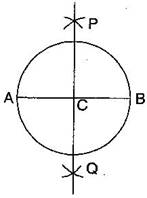
(i) Draw a circle with centre C and radius 3.4 cm.
(ii) Draw its diameter .
(iii) Taking A and B as centers and radius more than half of it, draw two arcs which intersect each other at P and Q.
(iv) Join PQ. Then PQ is the perpendicular bisector of .
We observe that this perpendicular bisector of passes through the centre C of the circle.
Question 8.Draw a circle of radius 4 cm. Draw any two of its chords. Construct the perpendicular bisectors of these chords. Where do they meet?
Answer: Steps of construction:
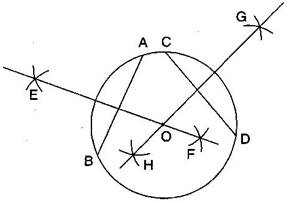
(i) Draw the circle with O and radius 4 cm.
(ii) Draw any two chords and in this circle.
(iii) Taking A and B as centers and radius more than half AB, draw two arcs which intersect each other at E and F.
(iv) Join EF. Thus EF is the perpendicular bisector of chord .
(v) Similarly draw GH the perpendicular bisector of chord .
These two perpendicular bisectors meet at O, the centre of the circle.
Question 9.Draw any angle with vertex O. Take a point A on one of its arms and B on another such that OA = OB. Draw the perpendicular bisectors of and Let them meet at P. Is PA = PB?
Answer: Steps of construction:
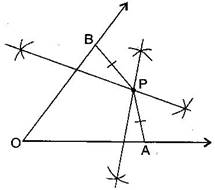
(i) Draw any angle with vertex O.
(ii) Take a point A on one of its arms and B on another such that
(iii) Draw perpendicular bisector of and
(iv) Let them meet at P. Join PA and PB.
With the help of divider, we check that
